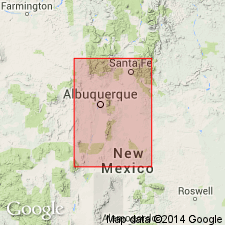
- Usage in publication:
-
- Fenton Hill granodiorite
- Modifications:
-
- First used
- Geochronologic dating
- Dominant lithology:
-
- Granodiorite
- AAPG geologic province:
-
- Southern Rocky Mountain region
Summary:
First[?] published use as an informal term for a distinctive Precambrian pluton west of the Valles caldera and 20 mi west of Los Alamos, Sandoval Co., NM in the Southern Rocky Mountain region. Intent to name and designation of type not stated. Known only in the subsurface in the Fenton Hill area. Is similar to the surface exposures of the Sandia pluton. Was encountered in 4 wells at Fenton Hill between 8.498 and 9,843 ft as a single continuous intrusive. Consists of homogeneous, typically nonfoliated, sphene-bearing, biotite-rich granodiorite. The major minerals are quartz, sericitized plagioclase, microcline, and biotite. Accessory minerals are sphene, zircon, opaque oxides, myrmekite, and apatite. Epidote and calcite present as accessory minerals. Plots near the granodiorite-quartz monzonite field, and close to the Sandia pluton(s). Intruded adjacent gneisses have a 162+-0.04 Rb/Sr age. Chemical composition of Sandia and Fenton Hill shown on tables. Rb/Sr isochron age of 1.5+-0.12 Ga and a Pb/Pb age on sphene and zircon of 1.5+-0.02 Ga reported by two different workers. Considered equivalent to "Sandia granite" on basis of similar mineralogy, chemistry, and geochronology. The high sphene content (1-1.5 percent) in the Sandia and Fenton Hill distinguishes them from other plutons in central and south-central NM.
Source: GNU records (USGS DDS-6; Denver GNULEX).
For more information, please contact Nancy Stamm, Geologic Names Committee Secretary.
Asterisk (*) indicates published by U.S. Geological Survey authors.
"No current usage" (†) implies that a name has been abandoned or has fallen into disuse. Former usage and, if known, replacement name given in parentheses ( ).
Slash (/) indicates name conflicts with nomenclatural guidelines (CSN, 1933; ACSN, 1961, 1970; NACSN, 1983, 2005, 2021). May be explained within brackets ([ ]).

